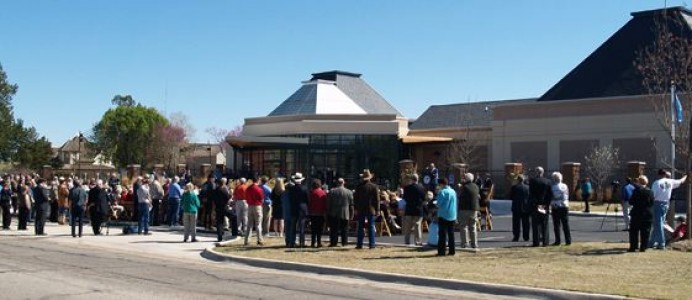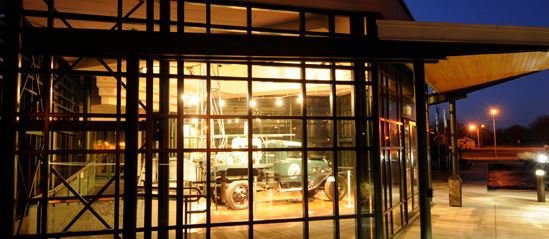Oklahoma museum opened in 2011 to preserve history of Sooners and the American West.
The Cherokee Strip Regional Heritage Center (CSRHC) in Enid, Oklahoma, preserves the history of the settling the Cherokee Strip — and the search for petroleum in northwestern Oklahoma. The museum opened in 2011 following six years of work by many Enid residents, including a leading independent producer.

Hundreds gathered for the April 1, 2011, opening of the $10 million Cherokee Strip Regional Heritage Center on the east side of Enid, Oklahoma.
Overlooking a Chisholm Trail watering hole, CSRHC stands on “one of the most meaningful spots in the history of the American West” and includes the Humphrey Heritage Village, site of the only remaining U.S. Land Office from the 1893 Cherokee Strip Land Run.
Staking a claim to a piece of land on the day of the land run was a hard journey for those who poured over the border on September 16, 1893. Known as the Cherokee Outlet Opening or the Cherokee Strip Land Run, it followed the more famous first land run into unassigned lands of former Indian Territory on April 22, 1889.
CSRHC Chairman Llewellyn “Lew” O. Ward III (1930-2016) addressed a crowd gathered at the latest cultural addition to Enid on April 1, 2011. “Opening the heritage center is the closing of one chapter, but just the beginning of another to fulfill our pledge of claiming our past and inspiring our future,” announced Ward, who was instrumental in establishing the facility.
The $10 million center’s opening followed six years of dedicated work, explained the independent producer, who died in March 2016 after leading state and national industry associations and receiving many lifetime achievement awards. “Exhibits and programs will make a significant impact on future generations,” explained Ward, who in 1963 founded Ward Petroleum in Enid.
Ward, a past chairman of the Independent Petroleum Association of America (IPAA), was presented the industry’s Chief Roughneck Award (1955 to 2019) by Lone Star Steel during the IPAA annual meeting in 1999. The American Oil and Gas Historical Society declared him an exceptional “oil patch preservationist” during its 2007 Energy Education Conference in Oklahoma City.

The Cherokee Strip Regional Heritage Center includes a 1927 portable drilling rig created by petroleum technology pioneer George E. Failing, who added a drilling rig to a Ford farm truck. The same engine that drove the sturdy truck across the oilfields was used to power its rotary drill.
Thanks to Ward’s commitment to building the facility, the Cherokee Strip Regional Heritage Center Inc. was created in 2005 through partnerships with the Oklahoma Historical Society (OHS), the Sons & Daughters of the Cherokee Strip Pioneers Association, and the Phillips University Legacy Foundation.

CSHHC Chairman Lew O. Ward (1939-2018) spoke at the 2011 opening. Ward served on the boards of the National Petroleum Council and the College of Engineering at the University of Oklahoma
The former heritage museum at the eastern edge of Enid became a property of the Oklahoma Historical Society in 1976 and is now the Cherokee Strip Regional Heritage Center, including the library.
Ward noted the new center’s oral history library contains more than 260 interviews capturing the stories of the Cherokee Strip from those who have lived them. “This growing library is an invaluable component of historical research for our region,” he added.
“Trained staff and volunteers collect the oral histories of people from the Cherokee Strip and Northwest Oklahoma,” Ward said. “The interviews are then transcribed and made available to the public and for use in the Research Center.”
Further, a the center has hosted teachers seminars on the Enid campus of Northwestern Oklahoma State University, according to Ward. The seminar explained to teaches how to incorporate lessons of leadership into their curriculum through the study of history,” he explained.
In November 2013, the center was selected by the Oklahoma Energy Resources Board (OERB) to partner in the statewide school education programs — OERB Homeroom.

In 1917, Herbert H. Champlin purchased a small refinery on the outskirts of Enid. By 1944 his company operated service stations in 20 states.
OERB spends millions of dollars annually to provide teacher training, curricula and programs that bring the petroleum industry to classrooms across the state — and offers free field trips to selected museums. “We are thrilled that the Heritage Center has been chosen to partner with OERB in their school education program,” said Museum Director Andi Holland in 2011.
“The heritage center’s Dave Donaldson Oil and Gas Gallery is well equipped marking the beginnings of oil and gas production in the Cherokee Strip through its economic importance to Northwestern Oklahoma today,” Holland added. The center’s gallery includes a series of interactive features about how natural resources are found, produced and refined.
A program already created by the heritage center’s education department is called “Boom and Bust, Natural Resources in the Cherokee Strip,” said Cody Jolliff, the Enid museum’s education director.
“This partnership will allow more students to attend the heritage center and learn more about Northwest Oklahoma and the rich natural resources that impact our lives,” Jolliff added.
Cherokee Strip Regional Heritage Center exhibits include: The Outlet – Learn about life before the land run, and how the run changed the course of history; The Land & the People Gallery – Hear the stories of settlers in the years after they staked their claims.
Also among the exhibits, the Thelma Gungoll Phillips University Gallery – Celebrate the founding and history of the first private university in the state.
The Dave Donaldson Oil & Gas Gallery offers a Champlin Oil exhibit. “The Champlin Refining Company, which for many years held the distinction of being the nation’s largest fully integrated oil company under private ownership, was based at Enid,” according to the Oklahoma Historical Society.
The Sooner State’s petroleum industry began one decade before statehood with an 1897 oilfield discovery near a trading post called Bartlesville.
_______________________
Recommended Reading: Oil in Oklahoma (1976); Oil And Gas In Oklahoma: Petroleum Geology In Oklahoma
(2013); The Oklahoma Petroleum Industry
(1980). Your Amazon purchase benefits the American Oil & Gas Historical Society. As an Amazon Associate, AOGHS earns a commission from qualifying purchases.
_______________________
The American Oil & Gas Historical Society preserves U.S. petroleum history. Please become an AOGHS annual supporter today and help maintain this energy education website and expand historical research. For more information, contact bawells@aoghs.org. Copyright © 2025 Bruce A. Wells. All rights reserved.
Citation Information – Article Title: “Cherokee Strip Regional Heritage Center.” Authors: B.A. Wells and K.L. Wells. Website Name: American Oil & Gas Historical Society. URL: https://aoghs.org/cherokee-strip-regional-heritage-center. Last Updated: March 28, 2025. Original Published Date: June 1, 2011.


